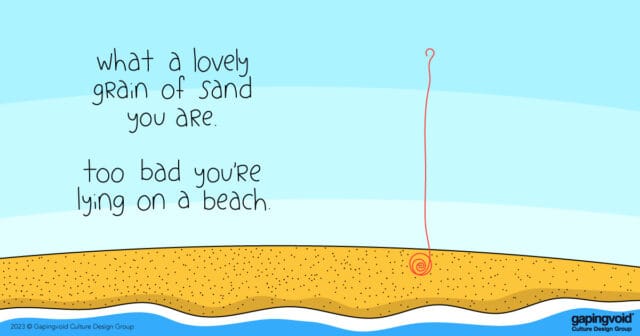[“New York Story 1”: Part of The Marfa Project. Click here to enlarge etc.]
Kate Helber over at Future State (a seriously smart woman, by the way) makes a good point about Change Management: A lot of it is neurological.
Like many people, at the time I tended to think of organizational change as a rational, logical process. That’s a great way to look at change — unless you’re the person experiencing change directly.
The reality is that changes in work, environment, team, relationships or home trigger neurological and physiological responses that aren’t in our control. Resistance is actually a natural reaction that we all experience when facing change, whether that change is good or bad.
So what advice does she give?
- Taking the personal element out of the equation and helping leaders understand that resistance is a natural physiological response is the first step.
- The second step is empowering them with better communication skills for dealing with frustrated, upset and disoriented people.
- Use pictures and small words, move slowly and don’t make sudden movements—these are simple tactics that can be used to serve the broader business strategy.
“Use pictures and small words”. Funny, that’s actually a big part of gapingvoid’s job, these days: Bringing visuals to the world of corporate change management.
If you aren’t part of that world, Change Management can seem a rather odd, byzantine place. Once you get closer, though, it’s really fascinating stuff.
So many companies need change, of course they do. Then again, it’s something really easy to scew up.
Therefore, if you’re any good at it; if you can avoid stepping on any of the many, many land mines buried out there, you can create a ton of value relatively quickly, and shareholders everywhere will be truly grateful.
But like I said, there are many landmines…





This is freaking awesome. As a New Yorker, I must own this. Selling any prints?
It will be soon, once we get Art Basel Miami over with for the year. Watch this space 🙂
Mr Hugh, can you share me about the important thing to be prepared when you start gapingvoid? thanks Mr..
Great insights! It was great read. I think the “Use of pictures and small words” is the key thing.I’ve been working as a business consultant in KPMG for the past 5 years.I have never thought about these ‘real’ facts.
Great insights! It was great read. I think the “Use of pictures and small words” is the key thing. I’ve been working as a business consultant in KPMG for the past 5 years. I have never thought about these ‘real’ facts.